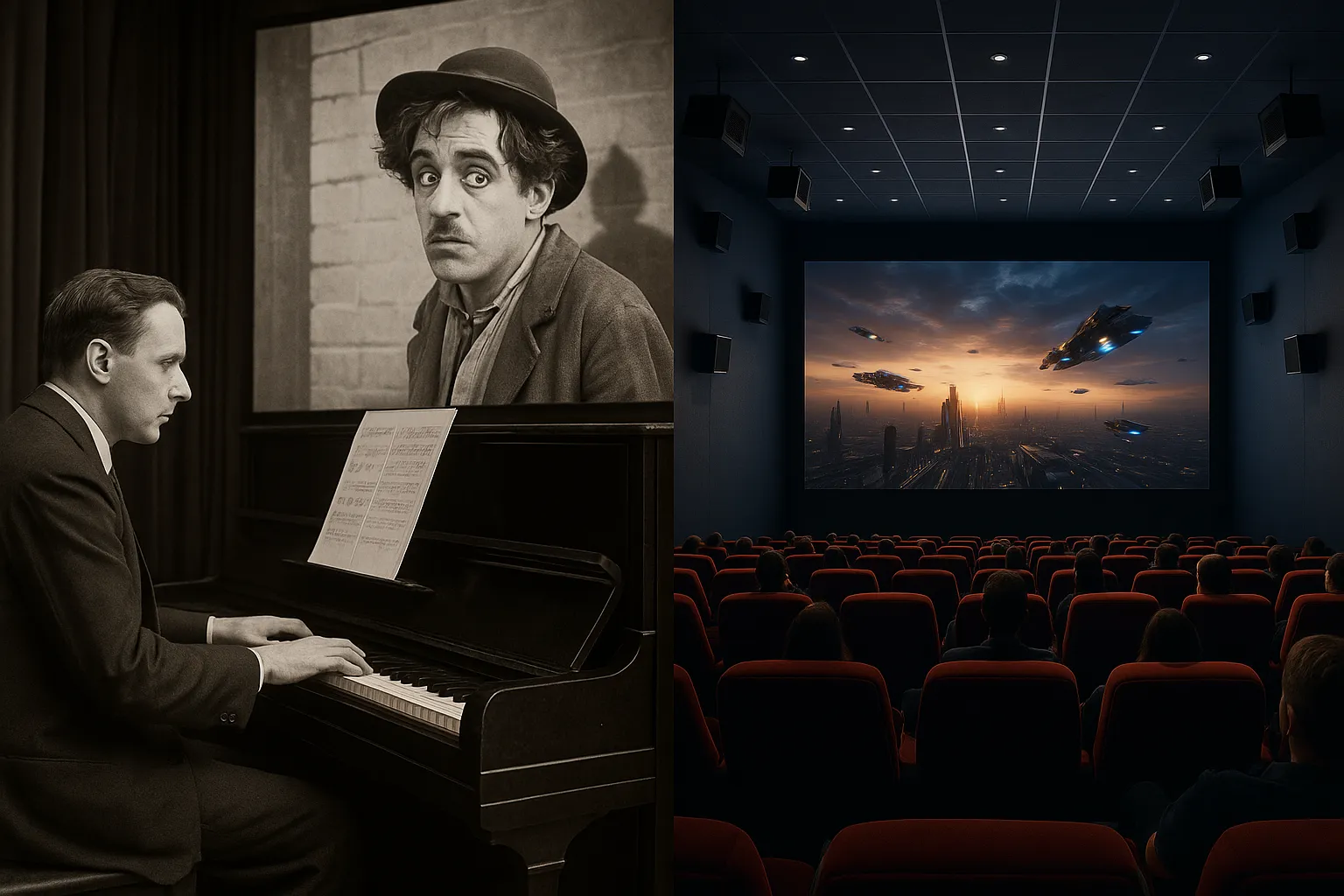Picture this: you’re watching a thrilling car chase, and every screech of tyres makes you grip your seat. Don’t you feel completely immersed in the action? That amazing feeling happens because good sound design makes you feel like you’re part of the scene.
Cinema audio has changed dramatically since the 1920s, when a lone pianist provided the only soundtrack to silent films. Nowadays, sound systems create three-dimensional audio experiences that can really draw you in.
In this article, we’re going to share our insights into how cinema sound evolved from simple musical accompaniment to today’s sophisticated audio systems. We’ll trace this fascinating evolution through:
- The era of live musicians and silent films
- The arrival of synchronised sound
- Stereo sound and multi-channel audio breakthroughs
- Digital audio revolution and surround sound
- Today’s immersive systems like Dolby Atmos
Ready to explore how cinema found its voice? Let’s dive in.
The Silent Era: Foundations of Cinematic Sound
Silent films weren’t silent at all. These early motion pictures had no recorded dialogue or sound effects, but live musical performances filled theatres with sound. In every movie theatre, there were some musicians who played alongside every screening and created the soundtrack as people watched the film.
Even though technology wasn’t advanced back then, using sound in this way proved that what you heard was just as important as what you saw on screen.
Let’s explore how these early sound pioneers created magic with just instruments and creativity:
Live Musical Accompaniment and the Early Orchestra
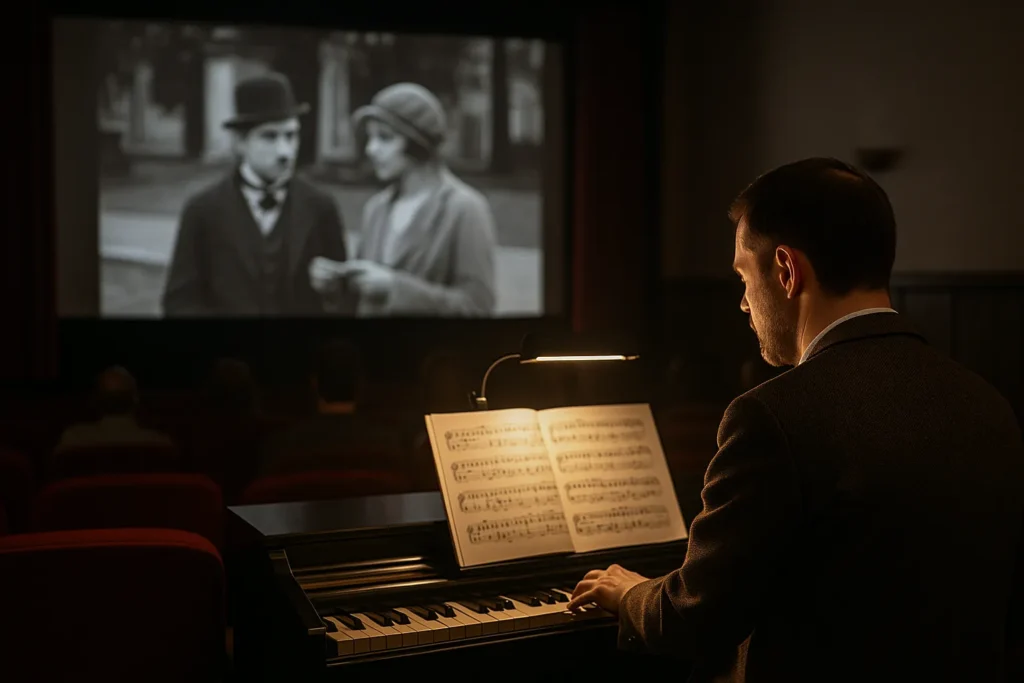
Imagine walking into a grand cinema in the 1920s and hearing a full orchestra tuning its instruments. At that time, large theatre orchestras played tunes that composers specifically wrote for the movies.
But not every theatre could afford a full orchestra, so talented pianists stepped in to save the day. Pianists provided a continuous soundtrack, changing the audience’s emotional response throughout the film. When the hero faced danger, dramatic chords warned the viewers of trouble ahead. During romantic scenes, gentle melodies made their heart flutter.
The use of sound in these early films helped people get into what was happening on screen. This way, the audience felt connected to the story emotionally and so every scene hit them much harder.
The Role of Early Sound Effects and Ambience
You might wonder how they made a horse gallop sound real without speakers? The answer lies in how theatre musicians became creative sound wizards, using ingenious methods to bring scenes to life. They rattled metal sheets for thunder, clicked coconut shells for hoofbeats, and shook dried beans in containers for rainfall.
As these techniques became more popular, theatre owners realised they needed specialists. Musicians used special gadgets for realistic sound effects like thunder, wind, and even gunshots. Some theatres hired dedicated sound effects operators who worked alongside the orchestra.
But audiences wanted something more. They craved films where actors could speak and be heard clearly. This growing demand would soon change everything about how movies were made and experienced.
The Dawn of Synchronised Sound
For ages people had been trying to add recorded sound to films, but the technology back then didn’t support their vision. Then around the late 1920s, everything changed. Movies from this era could finally talk, and it completely changed the film industry forever. The arrival of sound increased movie attendance, which jumped from 50 million a week in the mid-20s to 110 million in 1929.
Going from silent films to sound films marked one of the most remarkable moments in film history, and audiences couldn’t get enough of this new experience.
Let’s explore the two breakthrough technologies that made this transformation possible:
The Vitaphone System and “The Jazz Singer”
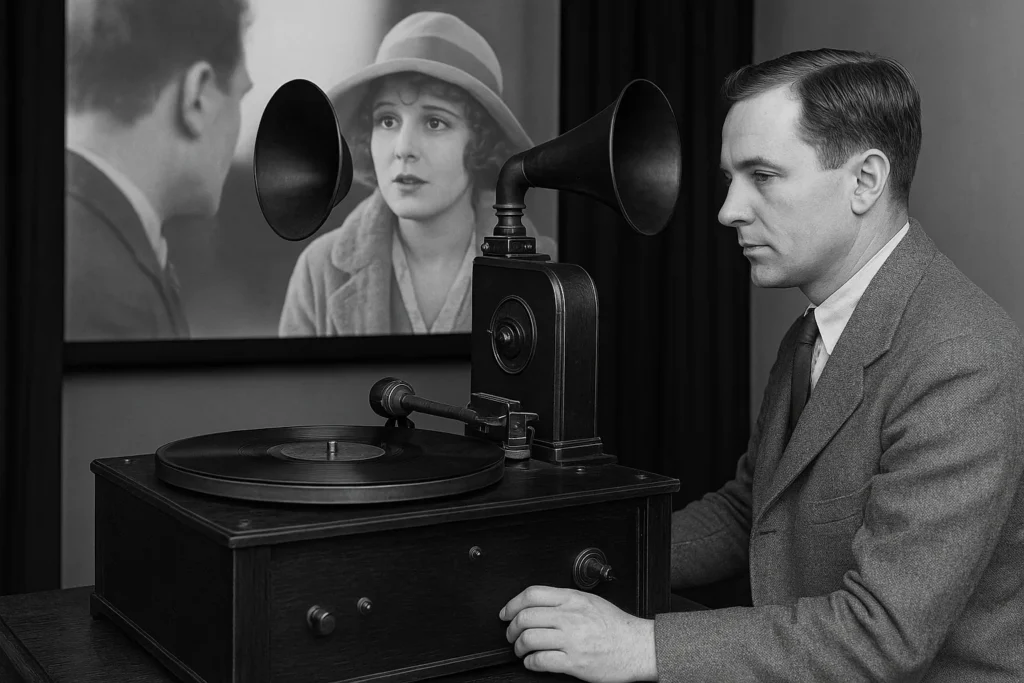
Warner Bros. took a massive gamble with their Vitaphone system, which put sound on separate records that played alongside the film. The technology was challenging to get right, but when it worked, audiences were amazed to hear actors speaking and singing in perfect sync with their on-screen movements.
The Jazz Singer, released in 1927, became the breakthrough everyone had been waiting for. This film became a massive hit, with synchronised sound so convincing that audiences felt like they were watching real life unfold.
However, Al Jolson‘s famous line from the movie, “You ain’t heard nothin’ yet,” seemed a promise to audiences about what cinema could become.
The film’s massive success basically ended the silent film era overnight and made talking pictures the new standard that every studio rushed to copy.
The Transition to Sound-on-Film Technology
Vitaphone worked well enough to get things started, but it had some serious drawbacks. Records could break or get out of sync, which drove cinema operators mad with frustration. Suddenly, sound engineers discovered that embedding sound directly onto the film strip eliminated these frustrating synchronisation problems.
This new approach meant everything stayed together in one piece. Optical soundtracks had sound built into the film strip itself, appearing as wavy lines along the edge of each frame. This technology made projection much smoother and audio far clearer than the old record system. Plus, if you needed to edit a film, you could cut both picture and sound together without worrying about matching separate records (fascinating, right?).
When the filmmakers saw the success of sound films, they understood how different types of audio could make movies even more thrilling and emotionally powerful. So, innovation in sound technology took off. Let’s see some of them now.
Golden Age Innovations in Sound Design
If the early days of synchronised sound were used to make actors talk, the 1930s and 1940s were used to make movies truly come alive. Sound technology became smarter, adding more detailed sound effects that could transport you anywhere. And the film industry saw how much sound could add to a story.
Here are two groundbreaking innovations that changed cinema forever:
The Art of Foley: Creating Realistic Sounds
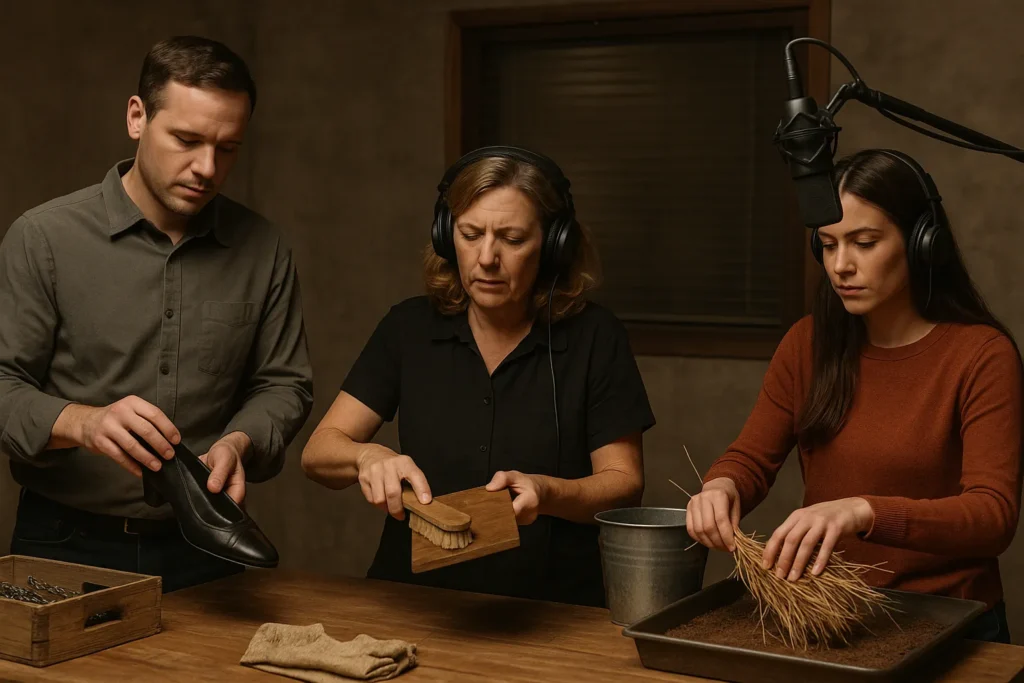
Foley is the art of creating realistic sound effects in post-production using everyday objects. When someone crunches cornflakes to create the sound of footsteps on gravel, this creative process is called Foley work. It is named after Jack Foley, who created these sound techniques in the 1920s.
You’ll be amazed to see how the Foley artists meticulously create everyday sound effects by hand, from the rustle of clothing to the clatter of dishes. They might use coconut shells for horse hooves or celery stalks for breaking bones. This special sound production makes movie actions sound super real and adds authenticity that audiences feel rather than consciously notice.
Orchestral Scores and Their Emotional Impact
A great movie score can make you feel everything the characters do. Music has this incredible power over our emotions. Think about that moment when the music swells during a climactic scene and you’re suddenly completely caught up in the story. Amazing, isn’t it?
Better recording technology changed everything for film music. Studios could now capture the full beauty of orchestras with fantastic clarity. So composers could use music to make you feel exactly what they wanted you to feel (happy, sad, scared, excited, and whatnot). The right music could take you there instantly.
Now, let’s move on to see how these innovations laid the groundwork for even more exciting developments in cinema sound.
The Rise of Stereo and Surround Sound
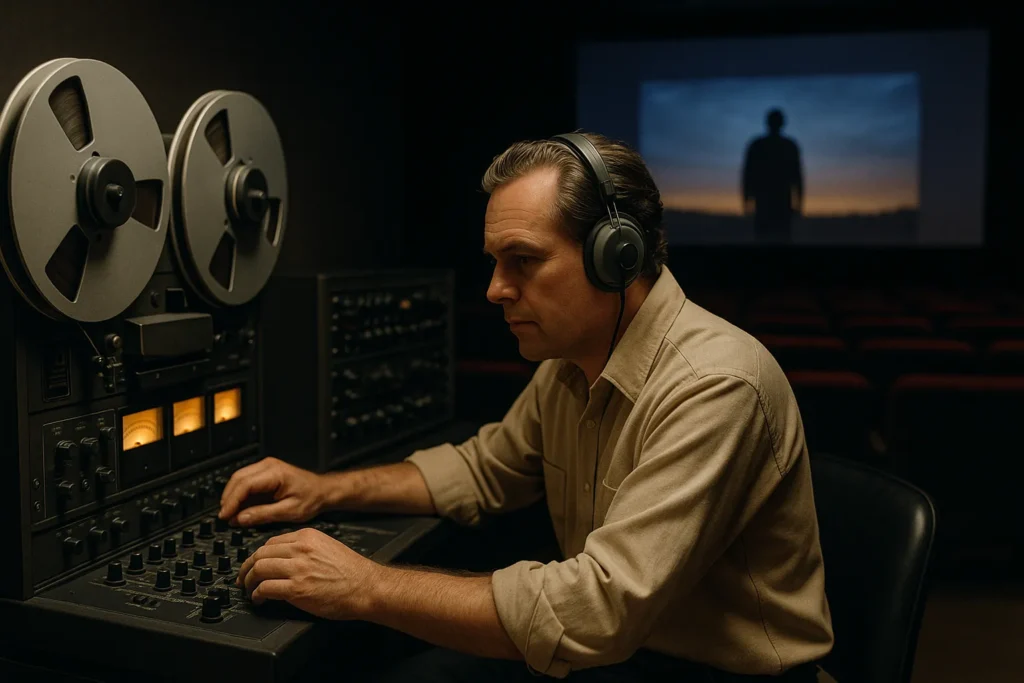
When audiences first heard sound coming from multiple directions instead of just straight ahead, it felt like magic. Early attempts at multi-channel audio aimed for a more immersive film sound that could wrap you in the story. This period marked the beginning of spatial audio in cinema.
Let’s see how stereo and surround sound have played their role:
Early Experiments with Multi-Channel Audio
Pioneering efforts explored how multiple speakers could enhance the cinematic experience. Studios started getting creative with where they placed their speakers around theatres. So, initial multi-channel sound systems used multiple speakers and separate audio tracks. For example:
- Walt Disney’s Fantasia used a special system called Fantasound in 1940
- Cinerama employed seven channels of audio in the 1950s
- Some theatres even tried speakers in the ceiling
However, these early setups were complicated and expensive to maintain. That’s why most cinemas stuck with simpler single-speaker systems until better technology came along. These early audio efforts built the foundation for future spatial sound innovations.
Dolby’s Revolutionary Impact on Cinema Audio
The name Dolby became synonymous with superior sound in the cinema, and for good reason. Ray Dolby completely transformed how audiences experienced movies, making the sound feel three-dimensional and alive. Dolby Stereo gave filmmakers new creative tools to tell their stories with much more emotional punch.
Then came the next big leap. Dolby Digital brought us digital multi-channel audio, which was like upgrading from a scratchy radio to crystal-clear CD quality. Who knew that better sound could make you jump higher during scary scenes? Dolby’s innovations became the industry standard, raising expectations for sound production everywhere.
Improving the sound in cinema didn’t end here, though, as even more exciting digital developments were just around the corner.
The Digital Audio Revolution
The 1990s brought a complete change in how movies handled sound. Digital technology replaced analogue systems that studios had used for decades, finally solving the annoying hiss and crackling sounds. This eliminated the quality loss that had troubled film sound for years.
Here’s what digital audio systems brought us:
CD-Quality Sound Comes to Cinemas
When cinema sound moved to digital, it brought consistent, pristine sound quality to every theatre around the world. No more worrying about whether your local cinema had a good or bad sound system. Plus, these new digital formats solved distribution problems like film reels getting damaged during shipping and sound quality getting worse with each copy made. As a result, getting perfect audio to thousands of theatres simultaneously became so easy.
Now, audiences could hear exactly what filmmakers intended, whether they were watching in a fancy cinema or their neighbourhood theatre. The difference was like comparing a scratchy old vinyl record to a brand-new CD.
Object-Based Audio: Dolby Atmos and Beyond
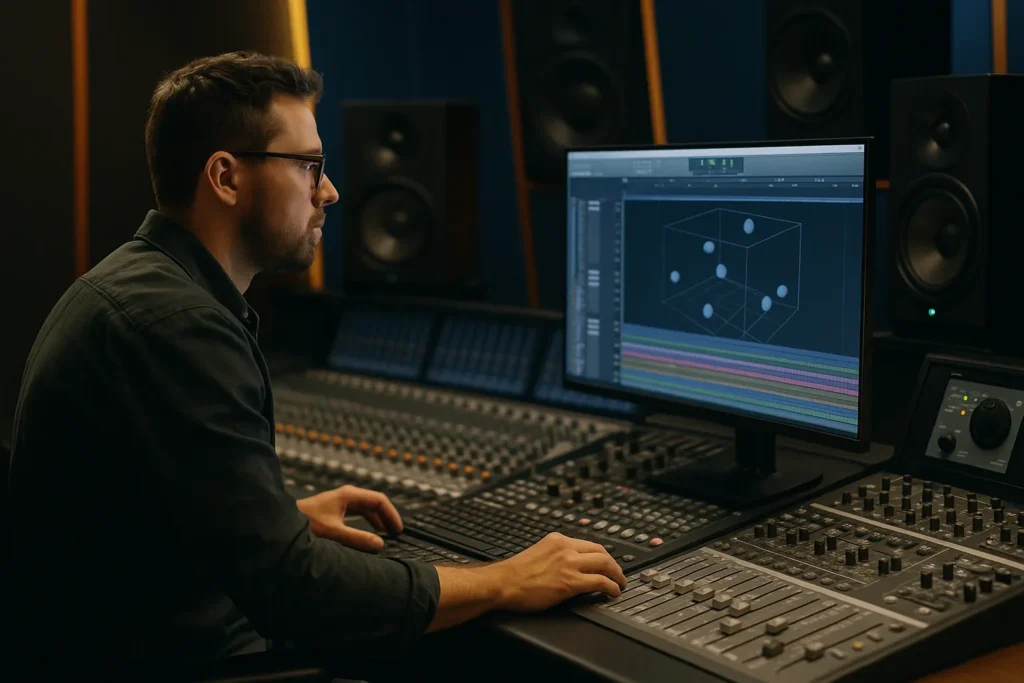
But digital sound didn’t stop there. The next revolution came with object-based audio systems. Advanced audio technologies like Dolby Atmos treat each sound as a separate object that can move freely through three-dimensional space around you. Instead of just left and right speakers, sound can now come from above, behind, and all around.
The future promises even more realistic and enveloping film sound technologies:
- Binaural audio that tricks your brain into hearing 3D sound through regular headphones
- Haptic feedback systems that let you feel explosions and crashes
- AI-powered sound that adapts to your hearing
At this rate, we’ll probably end up with cinema seats that give you a gentle breeze when there’s wind on screen. Now that would be taking immersion a bit too far!
A Symphony of Innovation
Cinema sound has come such a long way since the days of silent films. What started with live pianists playing alongside movies has grown and become amazing audio systems that make you feel like you’re right in the action.
From the first talking pictures to today’s Dolby Atmos technology, every step forward has made movies more exciting and enjoyable for audiences everywhere.
Want to see how cinema sound has changed over the years? At The Whiteladies Picture House, you can enjoy both old and new movie experiences. Watch classic films on our original 35mm system in our traditional theatre, or catch the newest blockbusters with modern digital sound that will blow you away.
Come see for yourself why great sound makes every movie better. Book your tickets today.
